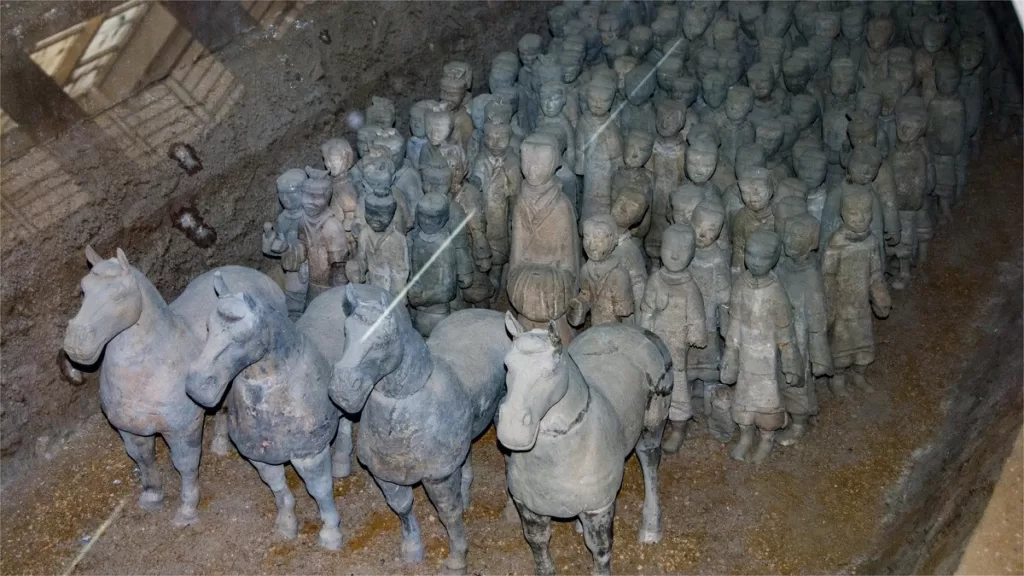Grabmal des Königs von Chu, Xuzhou - Eintrittskarten, Öffnungszeiten, Lage und Highlights


The King of Chu Tomb (狮子山楚王陵), situated on Lion Mountain in the urban area of Xuzhou City, has captivated archaeologists and history enthusiasts alike since its discovery by the renowned archaeologist Wang Kai. This archaeological marvel reveals the mysteries of an ancient era, shedding light on the burial practices and opulent lifestyle of the Chu kingdom during the Western Han Dynasty.
The identity of the tomb’s occupant remains somewhat enigmatic, with suggestions pointing towards the possibility of it being the resting place of Liu Wu, the third generation King of Chu during the Western Han Dynasty (though subject to debate). It is believed that, in the aftermath of the “Rebellion of the Seven States,” Liu Wu faced defeat in battle and, to prevent implicating his family, chose the path of self-sacrifice, leading to a hurried and possibly incomplete burial. Despite its vast scale, various pieces of evidence indicate that the tomb might not have been entirely finished.
Inhaltsübersicht
- Grundlegende Informationen
- Standort und Transport
- Highlights of King of Chu Tomb
- Vlog about King of Chu Tomb
- Attractions near King of Chu Tomb
Grundlegende Informationen
| Geschätzte Dauer der Tour | 1 Stunde |
| Ticketpreis | Included in the ticket of Han Culture Scenic Area, which costs 90 RMB |
| Die Öffnungszeiten | 8.30 – 17.00 (1st April – 31st October) 8.30 – 16.30 (1st November – 31st March) |
| Telefon Nummer | 0086-0516-83566263 0086-0516-83167053 |
Standort und Transport
The King of Chu Tomb is located in the Yunlong District of Xuzhou City, Jiangsu ProvinceChina, in der Bingmayong Road 1. Um dorthin zu gelangen, können Sie einen der folgenden Wege wählen:
Bus: Nehmen Sie den Bus 49, 65, 71, 79, 92, 97, 605 oder 608 und steigen Sie an der Haltestelle Chuwangling (楚王陵站) aus.
Metro: Die nächstgelegene U-Bahn-Station zum Grabmal des Königs von Chu ist Huangshanlong (黄山垅) auf der Linie 1. Nachdem Sie den Bahnhof am Ausgang 1 verlassen haben, gehen Sie etwa 800 Meter in Richtung Südwesten, um die Attraktion zu erreichen.
Highlights of King of Chu Tomb
Enormous Project

The tomb complex encompasses a series of interconnected components, including burial paths, courtyards, inner burial passages, corridors, ear chambers, side chambers, coffin chambers, and accompanying burial sites. The entire structure spans 117 meters in length, 13.2 meters in width, and covers an area of over 850 square meters, with a remarkable 5100 cubic meters of carved stone. It stands as the largest tomb ever unearthed in Xuzhou, with an unparalleled richness in excavated artifacts.
Numerous Artifacts

In 1984, the tomb yielded an extraordinary find of over four thousand terracotta soldiers and horses, reminiscent of the famed terracotta army in Xi’an. Among the treasures unearthed, the golden-threaded jade garment stands out as the finest in China’s archaeological history, boasting superior jade quality, the highest number of jade pieces, and impeccable craftsmanship. Additionally, the tomb revealed a treasure trove of hundreds of jade artifacts, nearly 300 seals, and seal impressions, a collection rarely seen in domestic archaeological discoveries.
Layout of the Tomb

The architectural brilliance of the King of Chu Tomb is evident in its emulation of an above-ground palace structure, characterized by its complex design and distinctive features. The tomb follows a symmetrical north-south axis layout, comprising three tiers of exposed vertical burial paths, courtyards, ear chambers, burial gates, corridors, side chambers, front halls, and rear halls. The twelve varied-sized chambers include facilities such as kitchens, bathing rooms, royal storerooms, enemy storerooms, treasury rooms, seal rooms, front halls, coffin chambers, chambers for ritual and music, and even burial chambers for the king’s consorts. This comprehensive array of facilities vividly reconstructs the extravagant lifestyle of the Western Han King of Chu, underscoring the prevalent burial ethos of treating death as an extension of life during the Han Dynasty.
Vlog about King of Chu Tomb
Attractions near King of Chu Tomb

Museum der Terrakotta-Krieger aus der Han-Dynastie

Zhulin-Tempel, Xuzhou
Historische Stätten in Jiangsu, Xuzhou Attraktionen